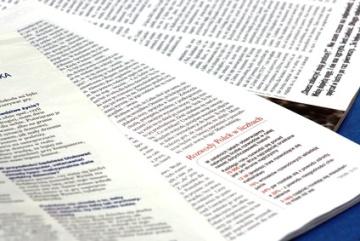A Journal Reviewer's Tips for Publication Success
April 23, 2015
A discussion on strategies for composing articles that get accepted into journal publication.
The first time you see your name published as the lead author of an article you are filled with pride. If an article is rejected you are filled with frustration.
Journal Article Fundamentals
I have been a reviewer for a number of journals for a long time and want to share what the process is and where, at least in my opinion and based on my experience, things may go wrong.
An anonymous article arrives on the desk (though, nowadays, obviously, the computer or tablet) of the reviewer. There is usually a copy of the abstract enclosed with the request for review so that the reviewer has an idea what the article is about, which should give an indication whether or not it is in her/his field of expertise. If the reviewer accepts and reviews, a few choices are given: accept as is, accept with minor revisions, accept with major revision, or reject.
The last two choices are the ones that are hard to make for the reviewer since, as one may assume, one frustrates the author(s) who may have spent a considerable amount of time in writing and, most likely even more in setting up and executing, the project the article is based upon.
The reviewer bases a decision to accept or reject an article on a number of factors including the physical structure of the article. The outline of an article is important: it needs to have an abstract, an introduction, a methods (and materials) section, a results section, a discussion, a limitations section, a conclusion and a series of references.
This blog will provide descriptions of the content of each section of the article outline. I will also discuss some of the typical mistakes, discussed per section that may lead the reviewer (or at least this reviewer) to suggest major rewrites or rejection. For obvious reasons I am focusing on wound care related articles.
Key Considerations in Composing Your Wound Care Journal Article
First, it is important to decide on the type of journal. This decision is driven by the focus of a journal and its readership. A complex article on the treatment of shock in necrotizing fasciitis should not target the same type of journal as an article on the prevalence of diabetic foot ulcers in a certain population. Along the same line: it is significantly more difficult to publish in The Journal of Trauma than in Wounds.
The Abstract: The first section a reviewer sees is the abstract, so it is important that this make a strong case for the article and serve the purpose of communicating the general landscape of the content.
An abstract needs to be short and to the point. It should have a basic outline of the type of study, the reason why the study was done, the most important results and a short description of the conclusion (which often is: “more extensive research is necessary”). I sometimes see abstracts that repeat whole sections of the article: it is not called an abstract without a reason.
At the same time, the value of an abstract should not be underrated: it is what most people see when they search online and its content will determine whether or not they want to read further or even order the article, often at a cost to the reader.
The Introduction: The article introduction needs to state the problem the research addressed and put it in context. This is not the same type of context found in the discussion section. Rather, it typically discusses prevalence and incidence to make the reader aware of how (un)common a disease is and in which population (vs. other cultures, races, socio-economical groups etc.) it occurs.
The introduction also discusses other necessary background information such as a biochemical role of a compound to be tested. In the introduction section the basic research question is stated (i.e. is X better than Y in Z type of wound, can a new technique reliably be used to assess biofilm?) and the introduction may also (briefly) indicate other research on the same or similar topics, although is it usually better to put this in the discussion section.
Determining the best suited audience for your research and creating a foundation for your content through the succinct defining of your article content in the abstract and context in the introduction are essential components of an article’s meeting acceptance in peer review.
Methods and Materials: The methods section and materials section are often combined into one chapter, which is fine unless the materials or methods themselves are very complex and/or require very extensive descriptions (specific journals may want to have them separated). It is also important to keep the readership in mind: an article that focuses on sophisticated cell interactions or biochemical measurements needs more explanation than one that measures the percentage of reepithelialization over time.
Proper descriptions of methods and materials are crucial: essentially they should contain all information necessary for the reader to repeat the research project on their own. The type of study needs to be described: is it a review, a retrospective analysis, a prospective randomized clinical trial or other type of study? In a true randomized controlled trial standardization is key: this is the ideal way to compare two (or more) types of treatments, but the downside is the fact that the type of patient and/or wound is narrowly defined due to inclusion and exclusion criteria and results cannot always be extrapolated to the population at large.
Often forgotten is information about study length, study cut-off points and how they were determined. Is time to full reepithelialization the study endpoint, wound reduction over a set time, or “simply” all results after a set time frame? The methods part must include information on how these endpoints are measured. Similarly, if pain or smell are endpoints, how are these measured and what type of (preferably validated) measuring techniques were used? This section, when relevant, also needs to have information on long-term follow up (important for scarring studies or recurrence-of-ulcer studies) and how this was executed (phone interview, visit to the clinic). By the way: long-term follow up is very difficult to pull off.
The type of statistical analysis used (if at all) is part of this section as well and information about IRB/Ethical Committees or animal husbandry guidelines should be included too.
Exclusion Criteria: Other important items in this section are inclusion and exclusion criteria: as mentioned, they largely determine to what extent the study results may apply to a specific population. In animal studies, type, sex, age and other details about the animals need to be included (the methods parts also always contains information that is redundant in most cases, i.e. the animals were given water ad libitum, but that is just an accepted convention).
Important details that also should be included in this section are adjunct therapies, i.e. information on whether or not offloading or compression was used, and if so, which type. This if often forgotten as is information on how (with a ruler, digital/photographic analysis) the way wound size (surface vs. volume) was measured. The way would size is expressed is also important. In this context: burn size should not be expressed as cm2 but as percentage of the patient’s body surface (TBSA) since burns larger than + 20% TBSA influence the entire body.
The Results: The results section of the journal article is just that: it should present the results. Many authors also include (some) interpretations of the results but these should go in the discussion part of the article. It is surprising how often certain data are forgotten (or perhaps were not recorded or completed for all study participants): typical forgotten items are age and sex of patients, location of wounds, types of wounds (when dealing with mixed indications), treatment time, time to healing or other outcomes, the number of visits to the clinic, etc.
If the study allows for more than one lesion per patient to be enrolled, it is important to separate the number of patients from the number of wounds: again, this is often not reported. Another common mistake when more than one wound per patient is allowed is to calculate the average age of patients by adding all ages and dividing them by the number of lesions instead of by the number of patients.
Creating Context for Your Article
Discussions: The discussions part puts everything in context, including, when relevant, historical context. In this section, results are compared to other results, which, for example, can be the same intervention/treatment for different types of disease or different treatments for the same disease. This part of an article also needs a section on statistics, if and when used. Literature references are crucial since the reader must be able to verify that statements are proven and not the author’s opinion. Preferably, referenced literature should be relatively new and not from the same author as the article itself.
Note: when writing articles citation software such as Easy-Bib and EndNote are of enormous help in keeping track of and sorting your references. They also allow the references to be quoted in any style a journal prefers. It is important to distinguish causation from correlation: in other words, is an observation caused by an intervention or do they just "happened to occur together."
Limitations: The limitations section is often forgotten. It is an important section, however, since it guides the reader on whether or not the article may be relevant for her/his clinical practice or research, or even lead to, for example, changes in the reader's clinic. Practically: an animal study needs to address that a wound in an animal, particularly a rodent, heals differently from those in humans and thus, although the results may be an indication of something, they cannot necessarily be extrapolated outright to the human situation. For the same reasons (different way of healing, and often not recognized enough by an author): results in chronic lesions cannot simply be extrapolated to acute wounds and vice versa. With regard to chronic wounds: the typical type of ulcer seen in humans does not occur in animals and, although chronic wound models in animals do exist, these wounds are "artificially" made chronic.
Conclusion: The conclusion component is just that: in a couple of sentences it summarizes the study set-up and results. It also may indicate future research on the same topic or end up with advice for the reader, based on the study results (this may be a negative advice as well).
Other Journal Article Considerations
Graphics
Graphics need to be clear and support the article. Legends need to explain the graphic and most journals also require an explanation of abbreviations and acronyms, even if they have been explained previously in the body text as well.
Keywords
Many journals require the author to attach keywords. For many authors keywords are often an afterthought, generated by the article submission system that "suddenly" requests them. Still, keywords are important and should be chosen carefully and appropriately: they help the article to be found via search engines and specific citation software.
Value
Make sure that your article has positive value.
This does not mean that the outcomes have to be positive: we also can learn from negative results with proper treatments or protocols.
Editor's Note: This blog has been modified from its original format as a series published in April-June of 2015.
About the Author
Michel H.E. Hermans, MD, is an expert in wound care and related topics, trained in general surgery, trauma care and burn care in the Netherlands. He has more than 25 years of senior management experience in the wound care industry. He has conducted a large number of clinical trials relating to devices and drugs aimed at wound care and related indications and diseases. Dr. Hermans speaks internationally and has authored many published works relating to wound management.
The views and opinions expressed in this blog are solely those of the author, and do not represent the views of WoundSource, HMP Global, its affiliates, or subsidiary companies.












Follow WoundSource
Tweets by WoundSource